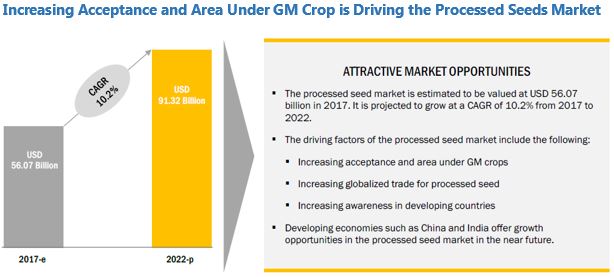
Process equipment market for seed industry includes processed seed market and seed processing equipment market. The processed seed market is estimated at USD 56.07 Billion in 2017 and is projected to reach USD 91.32 Billion by 2022, at a CAGR of 10.2% from 2017. On the other hand, the seed processing equipment market is projected to reach USD 3.25 Billion by 2022 from USD 2.00 Billion in 2017. Seed processing is crucial to make seeds ready for sowing. The necessity to increase food production and shrinking arable land has increased the demand for processed seeds, and consequently, seed processing equipment. Higher acceptance and area under GM crop, the rise in globalized trade for processed seed, and growth in awareness in developing countries are other factors driving the growth of process equipment market for seed.
The report also aims to do the following:
- To provide detailed information about the major factors influencing the growth of the process equipment market (drivers, restraints, opportunities, and industry-specific challenges)
- To analyze the opportunities in the market for stakeholders and provide details of the competitive landscape for market leaders
- To analyze the competitive environment of the process equipment market for seed industry
- To provide the analysis of the research & development spending and funding activities in the process equipment market for seed industry
- To project the size of the market, in terms of value in the key regions, namely, North America, Europe, Asia Pacific, South America, and the Rest of the World (RoW)
- To strategically profile the key players and comprehensively analyze their core competencies
- To analyze the competitive developments—mergers, acquisitions, expansions, investments, divestments, agreements, joint ventures, partnerships, collaborations, and new product launches—in the process equipment market for seed industry
Download PDF brochure @ https://www.marketsandmarkets.com/pdfdownloadNew.asp?id=112191741
Market Dynamics:
Drivers:
- Increasing Acceptance and Area Under GM Crop
- Increasing Global Trade for Processed Seed
- Increasing Awareness in Developing Countries
Restraints:
- High Price of Processed Seeds
Opportunities:
- Improving Seed Replacement Rate in Developing Countries
- Arrival of New Technologies With Potential Advantages on Existing Conventional Crops
Challenges:
- Regulations in GM Crop
Geographical Growth Scenario:
Geographically, the global process equipment market is divided into North America, Europe, Asia-Pacific, South America, and the Rest of the World (Middle East, and Africa). North America is one of the most technologically advanced regions. The seed processing & equipment market here is growing constantly due to the rising demand for quality raw material by the food chains, along with increasing demand of commercial seeds by the farmers for better yield in this region; Asia Pacific is witnessing promising growth in the production of processed seed in the past years due to increasing awareness about the benefits of commercial seed, especially in countries such as India and Indonesia. The demand for seed processing equipment is also projected to grow in the region.
Read more: https://www.marketsandmarkets.com/PressReleases/seed-process-equipment.asp
Leading Market Players:
The processed seed market is organized and is dominated by few large players such as Bayer (Germany), The Dow Chemical Company (US), Monsanto (US), Syngenta (Switzerland), and KWS Group (Germany), Cimbria (Denmark), PETKUS Technologie (Germany), Lewis M. Carter Manufacturing (US), Westrup (Denmark), and Alvan Blanch Development Company (UK).
Target Audience
- Associations and industry bodies
- Commercial research & development (R&D) institutions
- Processed seed manufacturers and suppliers
- Seed processing equipment manufacturers and suppliers
- Raw material suppliers and distributors
- Traders, distributors, and retailers
- Agricultural institutes, associations, and government agencies
- Commercial growers
- Researchers
- Industry experts